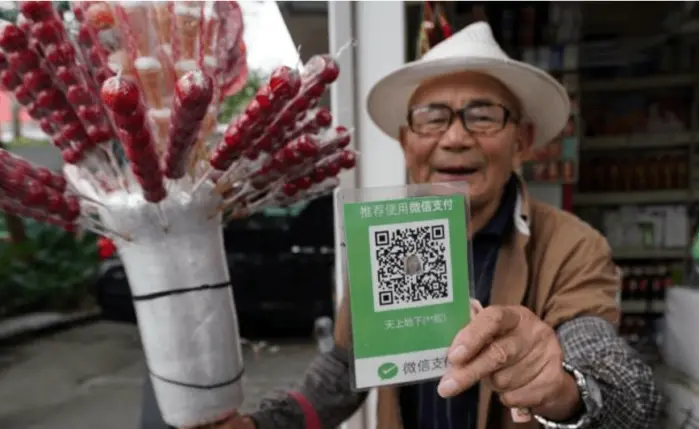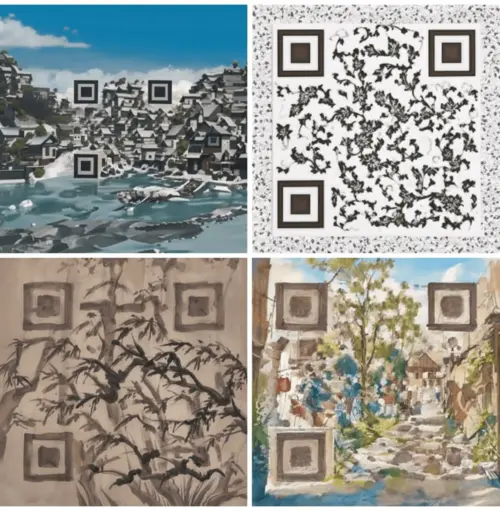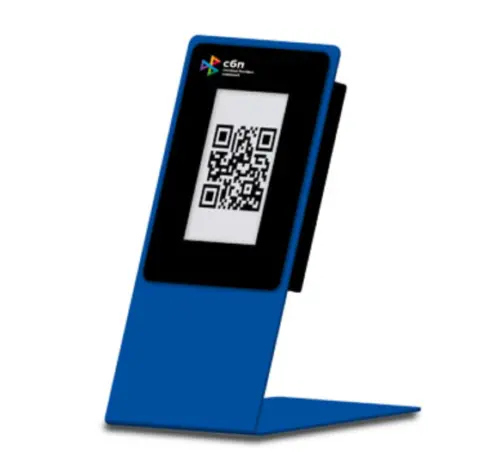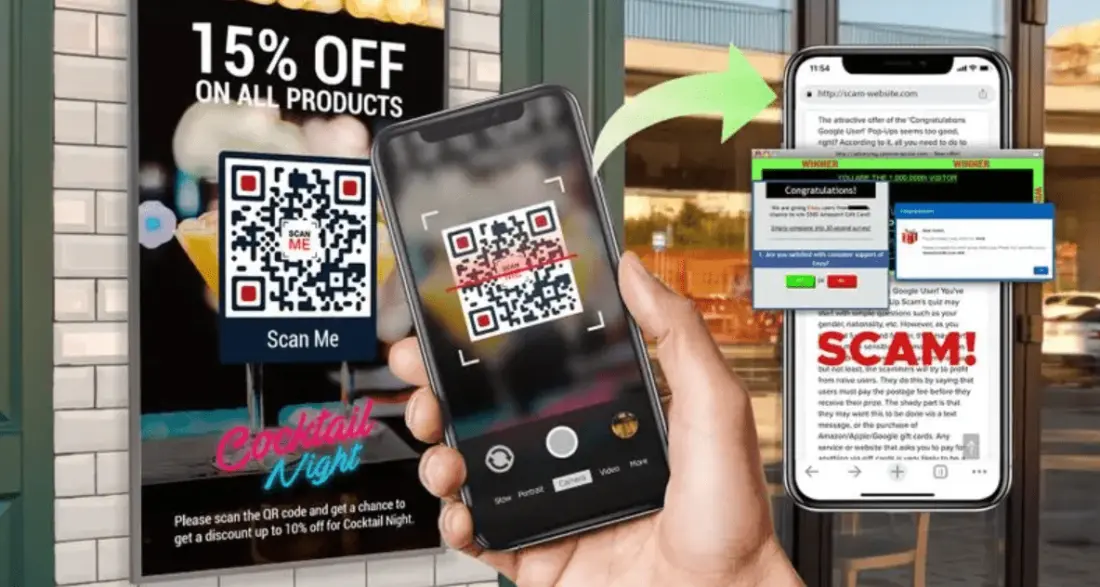Tomcat
Professional
- Messages
- 2,688
- Reaction score
- 1,014
- Points
- 113
If you, dear Russian Apple user, do not want to switch to Android, carry cards with you or put stickers on your favorite gadget, then there is only one way out - pay via QR. And in some countries, it is through “quaring” that most transactions take place. Today we’ll look at how QR payments work, what they are like, what’s cool about them, and why their share is growing by leaps and bounds.
If you decide to pay for udon at a Shanghai eatery with a card (even if that card is Union Pay), there's a good chance Uncle Liao will make a surprised face and hand you a cardboard with a QR code. After all, in China, almost all everyday payments are made by scanning black and white squares.

I see Uncle Liao with a cardboard box like this. But to the picture he is not selling udon, but some unknown Chinese wonders. But I think he sells udon too.
Yes, China is the undisputed leader in QR payments. But many other countries are also actively getting used to them. Quaring is especially developed in Asia - for example, in Thailand, South Korea, India, Uzbekistan and other countries. But in other regions it is far from dead and is actively growing. In Russia, QR payments are also doing well - the Russian Central Bank developed them before as a feature of the Fast Payment System, and in the last year and a half, for obvious reasons, their share has completely skyrocketed .
And various analytical firms (for example, this one ) predict that in a couple of years more than 2 billion people around the world will use QUAR payments on a daily basis. So, it is likely that payment via QR will become the dominant payment format in the near future, relegating cards to the background (I can’t guarantee it, but there’s a good chance).
So, how does quaring work in general, what kind of it is, and why is it better or worse than other methods. Let's figure it out.
A QR code, also known as Quick-Response Code, is simply some information, but encoded in the form of a set of black and white particles.
This information can be anything, for example:
But it just so happens that the QR code has several valuable features that make it an ideal technological basis for a whole galaxy of new payment services. And these are the features:

There is a cafe in China where cats wear T-shirts with QR codes. After scanning the cat, you can pay the bill or leave a tip. Agree, attaching a payment terminal to a cat will be much more problematic

Also, the QR code is beautiful. For example, a couple of months ago a Chinese craftsman learned how to make artistic kuars using Stable Diffusion. In terms of functionality, it is no worse than ordinary ones.
Now we are talking about QR payments. And here too there are differences:
Another option is dynamic QR. This is a more sophisticated tool. This kuar is generated separately for each payment. This means that you can embed additional information about this specific purchase into it - the amount of the transaction, the purpose of the payment, some comment, etc. Firstly, this payment process is more convenient and faster. And secondly, the seller may not check that he was paid exactly 640, and not 639 rubles. And vice versa - the buyer has no risk of accidentally pressing an extra zero.
Dynamic QR code is a cool and advanced thing. But there is a nuance - if the seller wants to generate dynamic quarries, then you can’t get away with cardboard. You will have to buy additional equipment that can handle this very dynamics.

For example, here is a dynamic QR screen that integrates with cash register equipment. This thing costs about 6-7 thousand rubles. The store can afford it, but our hypothetical Uncle Liao can hardly afford it anymore.
There are also several intermediate modifications. For example, when a static QR code leads to a dynamic web page. In this case, the QR code can be printed and not changed, but the payment chain will be extended by an extra download. Or another option - a static QR contains a link to a dynamic page, from which, when scanned, the current data is pulled into the payment application. The result is a nipple system where the QR does not need to be changed, but the buyer does not need to open an extra page. True, the likelihood that something will fit crookedly increases.
A few words should be said about the source of kuara. In the vast majority of cases, the QR is created by the seller (then it is Merchant presented QR), and the buyer reads it. But the reverse mechanics also happen - the buyer opens the QR code of his bank account, and the seller scans it, thereby debiting the required amount. In my opinion, this is the most convenient method for the buyer (although not the safest - more on that below), but the seller will need a little more functional equipment.

Customer presented QR code. The scanner can be a separate device or built into a payment terminal. Apparently, as the penetration of quaring grows, terminals with QR scanners will become increasingly popular.

No one has canceled the classic scam, when after scanning you end up on a phishing payment page, which for some reason asks you to enter your card details. However, QR here is only a redirection tool, and by no means the main culprit.
In the USA and Western European countries, by the beginning of the 21st century, card payments were already very developed. Local banks actively issued Visa, Mastercard, AmEx and others cards, and the population was already accustomed to their everyday use. Therefore, it was much more difficult for any exotic payment methods to squeeze out a share of the payment market.
But in all sorts of Thailand, Korea, Brazil and India, this was easier. Card penetration is much lower; for a significant portion of the population, payment cards were still exotic at that time. Consequently, most retailers (perhaps with the exception of large chain stores) had no incentive to spend money on purchasing payment terminals. But everyone could put a sign with a QR code next to the cash register.

In China, quaring is so dominant that many street musicians and beggars offer them donations in this way.
Then the classic “circles on the water” began. The business began to offer QR payment to customers → The population began to taste it and slowly realized that the new payment method was generally not bad and works in many places → The demand for quaring from customers increased → The business began to implement quaring even more actively. And so on in a circle.
It is worth noting that this growth spiral would not have been possible without the active involvement of two important players:

Typical Chinese market be like. The main thing here is not to miss.
Both “national” and “ecosystem” cuarings had their own trump cards up their sleeves. State services established reduced acquiring commissions (much lower than card fees), funded from the budget. Ecosystems did an excellent job of combining quaring with their other benefits - for example, they awarded cashbacks that could be used in their other products. It was also easier to train users of popular ecosystems to open the application for scanning - after all, the native interface is familiar and familiar.
As a result, QR has further strengthened its position in the payment markets of these countries. Yes, if you don’t take China into account, it’s still difficult to call quaring the main method. Rather, the first among the alternatives. But its share is growing. And who knows what will happen next.
Friends, if you liked the article, be sure to like it and write a comment. For example, tell us if you use QR payments, and if so (or not), why? Well, send it to a friend who is interested in payments, fintech and banking.
Soon I will write the second part, where I will analyze in more detail the key QR services in different countries - SBP, Chinese WeChat and AliPay, Indian UPI, Thai PromptPay and many others.
If you decide to pay for udon at a Shanghai eatery with a card (even if that card is Union Pay), there's a good chance Uncle Liao will make a surprised face and hand you a cardboard with a QR code. After all, in China, almost all everyday payments are made by scanning black and white squares.

I see Uncle Liao with a cardboard box like this. But to the picture he is not selling udon, but some unknown Chinese wonders. But I think he sells udon too.
Yes, China is the undisputed leader in QR payments. But many other countries are also actively getting used to them. Quaring is especially developed in Asia - for example, in Thailand, South Korea, India, Uzbekistan and other countries. But in other regions it is far from dead and is actively growing. In Russia, QR payments are also doing well - the Russian Central Bank developed them before as a feature of the Fast Payment System, and in the last year and a half, for obvious reasons, their share has completely skyrocketed .
And various analytical firms (for example, this one ) predict that in a couple of years more than 2 billion people around the world will use QUAR payments on a daily basis. So, it is likely that payment via QR will become the dominant payment format in the near future, relegating cards to the background (I can’t guarantee it, but there’s a good chance).
So, how does quaring work in general, what kind of it is, and why is it better or worse than other methods. Let's figure it out.
Why does a QR code work well with payments?
I would like to start with one simple thought:A QR code, also known as Quick-Response Code, is simply some information, but encoded in the form of a set of black and white particles.
This information can be anything, for example:
- The history of a statue in a museum. Then we draw the kuar on the nameplate and glue it next to the pedestal.
- Information about your Covid vaccination. In this case, the black and white ornament will appear in a special section on state services.
- Or, for example, your bank account details.
But it just so happens that the QR code has several valuable features that make it an ideal technological basis for a whole galaxy of new payment services. And these are the features:
- First of all, a QR code is an extremely undemanding thing. To display a QR code you only need a screen, and to scan it you only need a more or less tolerable camera. Simply put, a simple smartphone, which everyone has in the modern world, will be enough. We will take African tribes and Amish communities out of the equation. However, no one prohibits showing a QR code on a piece of paper. You can even attach a payment QR code to a cat - and then you will get a payment QR cat (I hope you will forgive me for this joke).

There is a cafe in China where cats wear T-shirts with QR codes. After scanning the cat, you can pay the bill or leave a tip. Agree, attaching a payment terminal to a cat will be much more problematic
- Secondly, QR codes offer a huge number of combinations. The number of unique combinations of black and white squares is so titanic that I will not list it here. Let me just mention that more than half a trillion (!) cuars are used in Chinese WeChat every year, and this is not even 0.001% of all possible combinations. In short, no matter how much the Chinese buy udon, we will have enough unique QR codes for a long time.
- Finally, over the past few years, everyone has learned to use QR codes. I think even the grandmothers in the village have heard at least something about this (unlike these NFCs of yours).

Also, the QR code is beautiful. For example, a couple of months ago a Chinese craftsman learned how to make artistic kuars using Stable Diffusion. In terms of functionality, it is no worse than ordinary ones.
What kind of payment QR codes are there?
So, although the QR code itself is an absolutely brilliant thing, it would be hard to call it rocket science. Of course, the Kuars also have technological differences - for example, methods of encoding information (digital, alphanumeric, byte, etc.). But in this article we will not dive deep into this - if you are interested, you can Google 100,500 technical articles about the technical nuances of these things.Now we are talking about QR payments. And here too there are differences:
- The first is the source of kuara. Who shows the QR code and who scans it - the seller or the buyer.
- The second is the saturation of the QR code with information. You can make a basic quarchik containing bank account information. You can add some additional information to it - for example, the purpose of payment. And also a specific amount, but here we are already moving on...
- ...to point number three - the dynamism of the QR code. Perhaps this is the main technological difference. A QR code can be static and dynamic, and here we need to go into more detail.
Another option is dynamic QR. This is a more sophisticated tool. This kuar is generated separately for each payment. This means that you can embed additional information about this specific purchase into it - the amount of the transaction, the purpose of the payment, some comment, etc. Firstly, this payment process is more convenient and faster. And secondly, the seller may not check that he was paid exactly 640, and not 639 rubles. And vice versa - the buyer has no risk of accidentally pressing an extra zero.
Dynamic QR code is a cool and advanced thing. But there is a nuance - if the seller wants to generate dynamic quarries, then you can’t get away with cardboard. You will have to buy additional equipment that can handle this very dynamics.

For example, here is a dynamic QR screen that integrates with cash register equipment. This thing costs about 6-7 thousand rubles. The store can afford it, but our hypothetical Uncle Liao can hardly afford it anymore.
There are also several intermediate modifications. For example, when a static QR code leads to a dynamic web page. In this case, the QR code can be printed and not changed, but the payment chain will be extended by an extra download. Or another option - a static QR contains a link to a dynamic page, from which, when scanned, the current data is pulled into the payment application. The result is a nipple system where the QR does not need to be changed, but the buyer does not need to open an extra page. True, the likelihood that something will fit crookedly increases.
A few words should be said about the source of kuara. In the vast majority of cases, the QR is created by the seller (then it is Merchant presented QR), and the buyer reads it. But the reverse mechanics also happen - the buyer opens the QR code of his bank account, and the seller scans it, thereby debiting the required amount. In my opinion, this is the most convenient method for the buyer (although not the safest - more on that below), but the seller will need a little more functional equipment.

Customer presented QR code. The scanner can be a separate device or built into a payment terminal. Apparently, as the penetration of quaring grows, terminals with QR scanners will become increasingly popular.
Are QR payments ideal?
In fairness, it is necessary to say about the disadvantages of quaring. They are like this:- The first is Internet addiction . Card payments can exist without the Internet. If necessary, payment terminals can read data from a card or NFC, store it in their memory, and when the Internet is turned on, transfer it to the payment system. Without the Internet, QR turns into a pumpkin from the word “completely”. So, if your store is located in a basement with a poor network, then quaring may be contraindicated for you (the buyer simply will not be able to load the page after scanning).
- The second is some security questions . Swindlers are not asleep here either. Let's say you demonstrate a QR with your account details wired up in a small stall, the seller of which turns out to be a scoundrel. He will quietly take a photo of your code, and your money will cry. Or another option - while the seller is gaping, the scammer will stick his scammer kuar on top of the real one. As a result, the money will not be used to pay for your goods. However, scams are also possible with bank cards. So, I’ll assume that quaring is not much inferior to it here (unless the scammers use other methods).

No one has canceled the classic scam, when after scanning you end up on a phishing payment page, which for some reason asks you to enter your card details. However, QR here is only a redirection tool, and by no means the main culprit.
- The third disadvantage is that QR payments require quite a lot of body movements . You need to take your phone out of your pocket or purse, then open the quaring application, then during the scanning process the camera will start to slow down... Then you press the “transfer” button, and the Internet will glitch and the confirmation will freeze. As a result, you stand in front of the cash register like a fool and think: “Has the money been written off, or do you need to do everything again?” It is precisely because of this hell of fine motor skills that many initially spit on these kuaras of yours and simply pay by card.
- In addition, there is often no cashback for quaring , or it is significantly less than for cards. This is the situation, for example, in the Russian Federation. The reason is that the commission for QR is lower than for cards, which means that banks have nowhere to get budgets for cashback. However, this is not the case in all countries - in some, all the fat cashbacks, on the contrary, are in QR payments (depending on how the size of commissions is related in a particular country). However, this is not such a minus. Or rather, for some it’s a minus for the consumer, but a huge plus for business.
Why is quaring especially popular among Asians?
QR payments are highly developed in many countries, but the guys from Asia (including, of course, the main fans of quaring - the Chinese, as well as the founders of the technology - the Japanese) and residents of some other so-called ones have a special love for them. "developing" countries. Why is that? I will assume that the explanation lies in the competitive situation in the markets during the years of the emergence and initial development of the technology.In the USA and Western European countries, by the beginning of the 21st century, card payments were already very developed. Local banks actively issued Visa, Mastercard, AmEx and others cards, and the population was already accustomed to their everyday use. Therefore, it was much more difficult for any exotic payment methods to squeeze out a share of the payment market.
But in all sorts of Thailand, Korea, Brazil and India, this was easier. Card penetration is much lower; for a significant portion of the population, payment cards were still exotic at that time. Consequently, most retailers (perhaps with the exception of large chain stores) had no incentive to spend money on purchasing payment terminals. But everyone could put a sign with a QR code next to the cash register.

In China, quaring is so dominant that many street musicians and beggars offer them donations in this way.
Then the classic “circles on the water” began. The business began to offer QR payment to customers → The population began to taste it and slowly realized that the new payment method was generally not bad and works in many places → The demand for quaring from customers increased → The business began to implement quaring even more actively. And so on in a circle.
It is worth noting that this growth spiral would not have been possible without the active involvement of two important players:
- Firstly, national payment infrastructure operators (mainly based on local central banks). They heard that the method was quite working. This means we need to ride this wave. Well, you know, in order to reduce the share of cash (and, on the contrary, increase taxes), to squeeze the market away from all sorts of Visas with MasterCards... And in general, with the help of clearing, to increase the share of domestic payments under your direct control. As a result, states began to cut down national QR payment services. Here are Indian UPI, Brazilian PiX, Thai PromptPay, and, of course, our SBP. By the way, this logic may partially explain why quaring has become especially popular in countries with active government participation in the economy.
- Secondly, consumer ecosystems that have begun to actively adopt quaring. As you know, the core of any self-respecting ecosystem should be a payment service that enhances the flow of client activity between different products. You know, so that an online cinema user has a financial incentive to try food delivery or a taxi aggregator (or whatever else ecosystems usually have). As a result, in countries with strong national ecosystems, QR payments have become an important payment method. Here are the Korean KakaoPay, and the Kazakh Kaspi, and, of course, the Chinese WeChat and Alipay.

Typical Chinese market be like. The main thing here is not to miss.
Both “national” and “ecosystem” cuarings had their own trump cards up their sleeves. State services established reduced acquiring commissions (much lower than card fees), funded from the budget. Ecosystems did an excellent job of combining quaring with their other benefits - for example, they awarded cashbacks that could be used in their other products. It was also easier to train users of popular ecosystems to open the application for scanning - after all, the native interface is familiar and familiar.
As a result, QR has further strengthened its position in the payment markets of these countries. Yes, if you don’t take China into account, it’s still difficult to call quaring the main method. Rather, the first among the alternatives. But its share is growing. And who knows what will happen next.
Friends, if you liked the article, be sure to like it and write a comment. For example, tell us if you use QR payments, and if so (or not), why? Well, send it to a friend who is interested in payments, fintech and banking.
Soon I will write the second part, where I will analyze in more detail the key QR services in different countries - SBP, Chinese WeChat and AliPay, Indian UPI, Thai PromptPay and many others.
